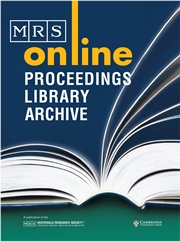Article contents
Modeling Corrosion Processes for Alloy 22 Waste Packages
Published online by Cambridge University Press: 21 March 2011
Abstract
The proposed waste package design for the disposal of high-level radioactive waste at the potential repository at Yucca Mountain, Nevada, consists of an outer container made of Alloy 22, a corrosion resistant Ni-Cr-Mo-W alloy, surrounding an inner container made of Type 316 nuclear grade stainless steel. Models to assess the influence of waste package degradation modes on the overall system performanceconsider uniform and localized corrosion processes. Based on measurements of passive anodic current density, the uniform aqueous corrosion rate of Alloy 22 is estimated to be slow, and long waste package lifetimes are projected in the absence of conditions that promote accelerated degradation processes. The initiation of localized corrosion is possible in chloride-containing waters with low concentrations of inhibiting oxyanions such as nitrate. Although propagation rates for localized corrosion are typically orders of magnitude greater than the passive uniform corrosion rates, the maximum penetration depth of localized attack may be limited to depths significantly less than the container thickness as a result of stifling andarrest of localized corrosion.
- Type
- Research Article
- Information
- Copyright
- Copyright © Materials Research Society 2006
References
REFERENCES
- 2
- Cited by




